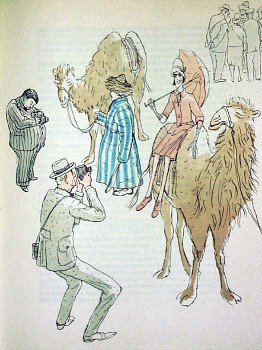|
|

THE BACTRIAN CAMELS AT A PHOTO SESSION. © Unknown. If you know an authour of this book or artist, please let us know. |
There are two types of camel: the Dromedary (single hump) and the Bactrian Camel (double hump). Both are native to the dry and desert areas of Asia and northern Africa. The name "camel" was originated from the Arabic "jamal" or the Hebrew "gahmal", all meaning "camel". Camelhair is the soft warm inner down of a Bactrian camel with a fiber structure similar to cashmere.
Bactrian camels have two coats: the warm inner coat of down and a rough outer coat, which is long and hairy. Camels shed their fiber in clumps consisting of both coats. One camel produces about 5 pounds (2 kg) of fiber annually. The down is usually 1-3 inches long with a micron count of about 15-22 microns. It has a staple length of over 2 inches, which is quite long for camel. Camel wool has unique characteristics of heat conductivity, softness and strength, and it does not felt easily. - Reference: PeaceOfYarn.com Camel's downhair can be used alone and spun into a yarn for knitting, but it is most often combined with fine wool for overcoating, topcoating, sportswear and sports hosiery. Because of the beauty of the natural colours, yarns and fabrics containing camel's hair are usually left in the natural camel color or are dyed a darker brown. |
|
The camel fiber colours
range from pale reddish to light brown. Chinese camelhair tends to be lighter in shade and finer than Mongolian camelhair. White (off white, cream) fleece is the most valued. Camel fiber is light-weight and extremely soft. As it is known, a 22 oz. of camel fabric is as warm as a 32 oz. of woolen fabric. -
Reference: Fabrics.net
In the Gobi, the camel serves multiple purposes. Camels are able to provide milk even during periods of extreme drought, and they are strong enough to carry everything, including a kitchen sink. And of course, there is the fiber. The outer hair, which is coarse and spun into yarn for making rope, is called male hair. The soft, inner coat, which is used for making felt and clothing, is called female hair. Of late, there is a growing demand in the export market for baby camel. Please find more information in Winter 2009-2010 Wild Fibers Magazine » |

|
🌟 Frequent Question: Is baby camelhair yarn rough and course?
🌟 A: Not at all. The baby camelhair handknitting yarn we sell is made from camels' undercoat fiber/hair and is exceptionally soft similar to cashmere. Coarse camel yarn is mainly used for weaving and rug making. Camel's undercoat: It is soft and warm inner hair of a Bactrian camel with a fiber structure similar to Cashmere. FYI Camels' wool is not usually sheared. It is mainly obtained from the hair/fiber, which is naturally fallen in spring. Camels can also be combed by hand with a coarse comb to obtain the fiber - the similar way used for cats, dogs, minks, some breeds of angora rabbits, and our other furry friends. If the camel yarn you purchased somewhere for hand knitting is course, please return it to the seller - it is made of the low quality fiber obtained from the outer guard hair. Please note that camels' wool does not felt easily!
|
‹ Lana Gatto Camel Hair ‹ Lotus Baby Camel Aran » |
‹ Lotus Baby Camel Handspun » ‹ Onion Garn Camel + Merino » |
☰ |
|
|
|
|
|
All rights reserved. Website comments to webmaster.
Product Index - General Gifts Index - How to Order - Shipping - Giveaways - About - Contact
Information is updated daily.
Images, photography, and content are copyright protected.
Please do not use the visual content without our prior permission.